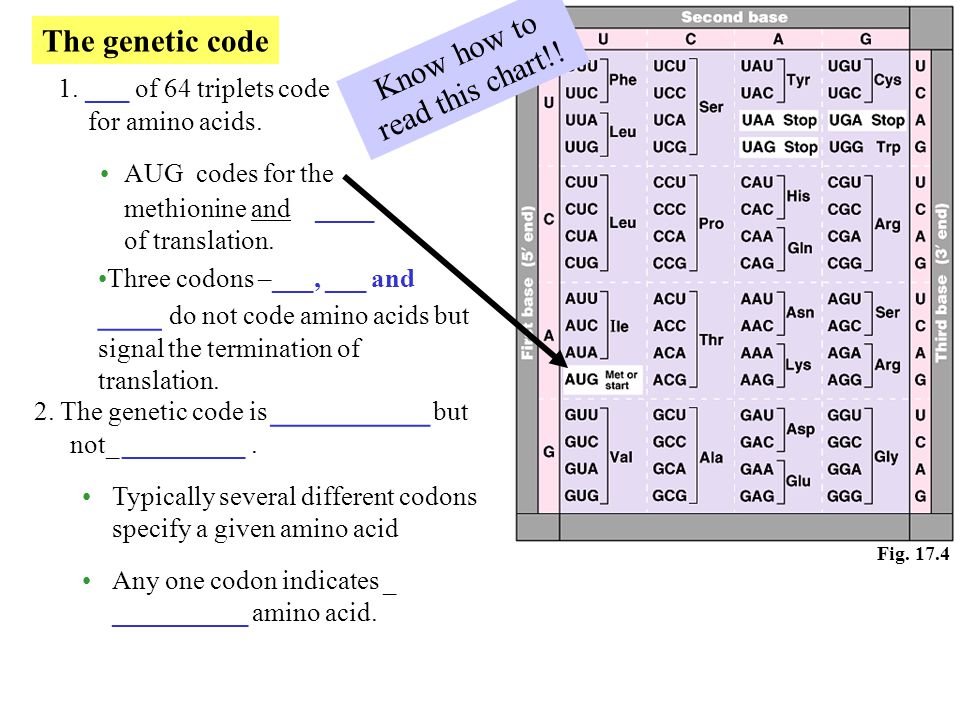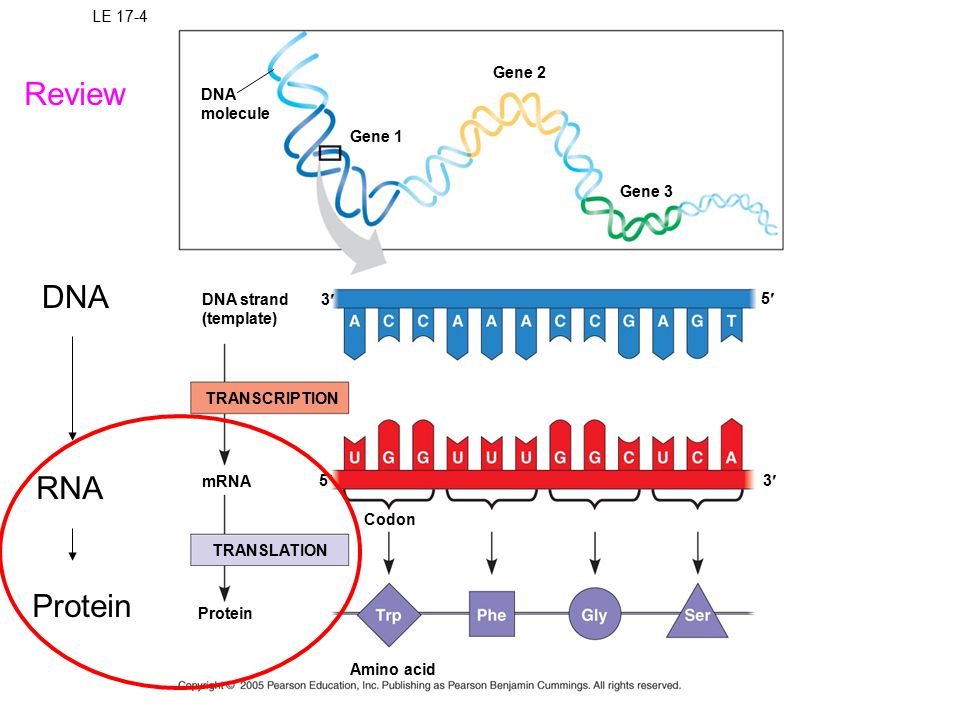May 4, 2018
Introduction using Power Point.
May 3, 2018
Start of chapter 11: The Control of Gene Expression
Introduction: shared how DNA technology has been used. This includes:
1) reproductive cloning ( article from Wall Street Journal, January 20, 2018- First Monkeys Cloned
2) therapeutic cloning
3) DNA, Guilt and Innocence- May 3, 1992 murder and rape of 3 year old
4) wholly mammoth
May 2, 2018
Test on transcription and translation
May 1, 2018
In studying for the test tomorrow, use the vocabulary and definitions given in class rather than using the Key terms chart given at the end of the package.
April 30, 2018
Class notes and vocabulary from chapter 10 will be collected and graded.
The class will practice for the test on Wednesday by working on a transcription and translation worksheet.
Monday, April 30, 2018
Monday, April 23, 2018
Chapter 10: Molecular Biology of the Gene. April 23, 2018 - April 27, 2018
April 26, 2018
Viruses: Genes in a Box.
Introduction to viruses - Notes and discussions.
April 25, 2018
The following pages from the text will cover the material covered in class:
Pages 517 through 532.
April 23, 2018
Translating the mRNA.
The class learnt how to body translate the mRNA using the tRNA.
Link on the link to watch the video also shown in class: Translating the mRNA
Class assignment: Transcription and Translation Worksheet.
Viruses: Genes in a Box.
Introduction to viruses - Notes and discussions.
April 25, 2018
The following pages from the text will cover the material covered in class:
Pages 517 through 532.
April 23, 2018
Translating the mRNA.
The class learnt how to body translate the mRNA using the tRNA.
Link on the link to watch the video also shown in class: Translating the mRNA
Class assignment: Transcription and Translation Worksheet.
Monday, April 16, 2018
Chapter 10: Molecular Biology of the Gene. April 16, 2018 - April 20, 2018
April 20, 2018
April 19, 2018
The class completed the work started on Wednesday, April 18, 2018.
Showed the video clip from NOVA; One Wrong Letter. Click on the link below to view.
Tay Sachs Disease
April 18, 2018
Class assignment; Transcription and translation. Answer questions 1 - 6 on page 471 of the textbook assigned to you. There will be time in class, tomorrow, April 19th to complete the assignment.
(Do not do the analysis questions found on the same page)
Transcription analogy:
The Big Dog Bit Ted and Ran off. (Each three letter word is an analogy for a codon)
ThB igD ogB itT eda ndR ano ff ( This sentence is an analogy for what happens due to a deletion of
one of the bases of the codon)


April 17, 2018
Introduction to transcription and translation. The class was taught how to transcribed the mRNA from the DNA. They also learnt how to read the genetic code chart.
The Image below shows the transcription of the mRNA from the DNA:

The nitrogenous bases present in the RNA are:
1) cytosine
2) guanine
3)adenine
4) Uracil
(The RNA is copied from the DNA molecule.)
April 16, 2018
The following pages from Biology; A Human Approach, ( the textbook assigned), will correspond to the lessons in class. Pages 516 - 532. (The genetic code chart can be found on page 530.
The class was taught how to copy the DNA.
The DNA is double helix.
The nitrogenous bases in the DNA are:
1) cytosine
2) guanine
3) adenine
4) thymine
The base pairing rule for copying the DNA is
Cytosine bonds with guanine ( C bonds with G)
thymine bonds with adenine ( A bonds with T)

Introduction to the chapter explained the role viruses played in identifying DNA as the genetic material.
Image of a bacteriophage.

April 19, 2018
The class completed the work started on Wednesday, April 18, 2018.
Showed the video clip from NOVA; One Wrong Letter. Click on the link below to view.
Tay Sachs Disease
April 18, 2018
Class assignment; Transcription and translation. Answer questions 1 - 6 on page 471 of the textbook assigned to you. There will be time in class, tomorrow, April 19th to complete the assignment.
(Do not do the analysis questions found on the same page)
Transcription analogy:
The Big Dog Bit Ted and Ran off. (Each three letter word is an analogy for a codon)
ThB igD ogB itT eda ndR ano ff ( This sentence is an analogy for what happens due to a deletion of
one of the bases of the codon)


April 17, 2018
Introduction to transcription and translation. The class was taught how to transcribed the mRNA from the DNA. They also learnt how to read the genetic code chart.
The Image below shows the transcription of the mRNA from the DNA:

The nitrogenous bases present in the RNA are:
1) cytosine
2) guanine
3)adenine
4) Uracil
(The RNA is copied from the DNA molecule.)
April 16, 2018
The following pages from Biology; A Human Approach, ( the textbook assigned), will correspond to the lessons in class. Pages 516 - 532. (The genetic code chart can be found on page 530.
The class was taught how to copy the DNA.
The DNA is double helix.
The nitrogenous bases in the DNA are:
1) cytosine
2) guanine
3) adenine
4) thymine
The base pairing rule for copying the DNA is
Cytosine bonds with guanine ( C bonds with G)
thymine bonds with adenine ( A bonds with T)

Introduction to the chapter explained the role viruses played in identifying DNA as the genetic material.
Image of a bacteriophage.
Monday, April 9, 2018
Genetics continued: Patterns of Inheritance April 9, 2018 - April 13, 2018
April 12, 2018
The class will do work on forensic assignment and study for test.
The students will have a substitute for the day.
April 11, 2018
The end of the chapter. Viewed the final slides from the PowerPoint.
April 10, 2018
Test on April 13, 2018. Click on the link below to Point Loma's home work page to view the details.
Pages 496 - 515 from the BSCS Biology Book, ( The textbook checked out to you), will cover the topics covered in class since the start of Genetics.
April 9, 2018
Students worked individually on Sex-Linked / X- linked worksheet.
The class will do work on forensic assignment and study for test.
The students will have a substitute for the day.
April 11, 2018
The end of the chapter. Viewed the final slides from the PowerPoint.
April 10, 2018
Test on April 13, 2018. Click on the link below to Point Loma's home work page to view the details.
Pages 496 - 515 from the BSCS Biology Book, ( The textbook checked out to you), will cover the topics covered in class since the start of Genetics.
April 9, 2018
Students worked individually on Sex-Linked / X- linked worksheet.
Tuesday, April 3, 2018
Genetics Continued: Patterns of Inheritance
April 6, 2018
Explain the Dihybrid cross worksheets from yesterday.
April 5, 2018
Class assignment: Dihybrid cross- Two different worksheets ( Individual work)
April 4, 2018
Pages 496 - 515 from the BSCS Biology Book, ( The textbook checked out to you), will cover the topics covered in class since the start of Genetics.
Sex linked / X-linked traits explained.
Sex-linked / X-linked disorders affecting mainly males was also explained.
Examples of a few sex-linked conditions are: hemophilia, red-green color blindness, congenital deafness, Duchenne muscular dystrophy, and some forms of mental retardation.
Click on the image below to enlarge.
April 3, 2018
Pedigree Practice Earlobe and Recessive trait.
April 2, 2018
Introduction to Gregor Mendel; The Father of Genetics
Introduction to dihybrid cross
In addition to his studying of single gene, Mendel also studied the phenotypic expression and segregation of two genes. This highlights his Law of Independent Assortment.
A dihybrid cross is a cross between two true-breeding parents that differ at two alleles.
For example: Peas that yellow and smooth crossed with peas that are green and wrinkled.
Let's make green and smooth the dominant trait.
Parental generation genotype:
ggSS x GGss
F1 Generation (First Filial Generation)
The phenotype : all green and Smooth
The genotype : GgSs
F2 Generation ( Second Filial Generation)
Results: 4 Different phenotypes.
Use the information explained in class and practice finding the phenotypes and genotypes of the F2 generation.
Explain the Dihybrid cross worksheets from yesterday.
April 5, 2018
Class assignment: Dihybrid cross- Two different worksheets ( Individual work)
April 4, 2018
Pages 496 - 515 from the BSCS Biology Book, ( The textbook checked out to you), will cover the topics covered in class since the start of Genetics.
Sex linked / X-linked traits explained.
Sex-linked / X-linked disorders affecting mainly males was also explained.
Examples of a few sex-linked conditions are: hemophilia, red-green color blindness, congenital deafness, Duchenne muscular dystrophy, and some forms of mental retardation.
Click on the image below to enlarge.
April 3, 2018
April 2, 2018
Introduction to Gregor Mendel; The Father of Genetics
Introduction to dihybrid cross
In addition to his studying of single gene, Mendel also studied the phenotypic expression and segregation of two genes. This highlights his Law of Independent Assortment.
A dihybrid cross is a cross between two true-breeding parents that differ at two alleles.
For example: Peas that yellow and smooth crossed with peas that are green and wrinkled.
Let's make green and smooth the dominant trait.
Parental generation genotype:
ggSS x GGss
F1 Generation (First Filial Generation)
The phenotype : all green and Smooth
The genotype : GgSs
F2 Generation ( Second Filial Generation)
Results: 4 Different phenotypes.
Use the information explained in class and practice finding the phenotypes and genotypes of the F2 generation.
Subscribe to:
Posts (Atom)
